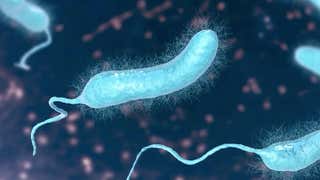Infection
‘Flesh Eating Bacteria’ Present For Weeks After Ian

- The bacteria, Vibrio vulnificus, can cause necrotizing fasciitis.
- Several people infected during or after Ian died.
- A similar spike in cases was seen after Hurricane Irma in 2017.
Sign up for the Morning Brief email newsletter to get weekday updates from The Weather Channel and our meteorologists.
Hurricane Ian fueled a weeks-long spike in a deadly type of bacteria along Florida’s Southwest Coast where the storm made landfall last year, new research shows.
The bacteria, Vibrio vulnificus, can cause a host of illnesses. The most serious of them is necrotizing fasciitis, a condition that has earned V. vulnificus the nickname “flesh-eating bacteria.”
“We were a little surprised at the detection rates, meaning the ease of finding Vibrios in collected samples, since we were not expecting these pathogens weeks after the hurricane,” Antarpreet Jutla, a study author and associate professor in environmental engineering sciences at the University of Florida, said in a news release.
(MORE: Hurricane Ian May Have Changed Florida Towns Forever)
The researchers also found Vibrio parahaemolyticus, which can cause sepsis and other serious medical conditions.
The connection was already known between V. vulnificus and Ian. The Florida Department of Health blamed a spike in cases last year on the storm and the CDC attributed at least 29 cases in Lee and Collier counties, the area where Ian made landfall, to Ian. Of those, nine people died. Three people had to have lower limbs amputated.
A list of Ian deaths obtained from the state shows that several of the people who died had pre-existing conditions that may have made them more susceptible to severe infection. All were exposed to coastal floodwaters from Ian, most either during the storm when they were trapped in their homes or afterward when they went to clean up.


A man looks at destroyed houses and debris surrounded by water in the aftermath of Hurricane Ian in Matlacha, Florida, on Oct. 1, 2022.
(RICARDO ARDUENGO/AFP via Getty Images)
A similar spike in vibrio infections was seen after Hurricane Irma hit Florida in 2017.
In September, the CDC issued a health alert warning of the potential for vibrio infections due to the potential for hurricanes and extremely warm ocean water temperatures. Vibrio thrives in brackish coastal waters like those found around Florida’s barrier islands. Scientists say it’s spreading further north up the East Coast due to climate change.
(MORE: Does El Niño Typically Skew The End Of Hurricane Season Earlier?)
The UF researchers said several conditions during and after Hurricane Ian contributed to the growth of Vibrio bacteria, including the amount of rainfall, changes in water temperatures and concentrations of chlorophyll in the water.
“This study highlights how important it is to understand climate, weather, and environmental processes on the distribution of clinically relevant pathogens that impact humans,” Jutla said.
Weather.com reporter Jan Childs covers breaking news and features related to weather, space, climate change, the environment and everything in between.
The Weather Company’s primary journalistic mission is to report on breaking weather news, the environment and the importance of science to our lives. This story does not necessarily represent the position of our parent company, IBM.

